This tense confrontation is taking place on a sultry late summer afternoon at North Cave Wetlands, and I’ve got a ringside seat. I’m crouching on the edge of Carp Lake. Ducks and grebes are swimming serenely on the steel grey water, but, in the shallows a metre or two in front of me, passions are running high.
Damselfly duels at North Cave Wetlands
Small red-eyed damselfly (C) Rod Jones
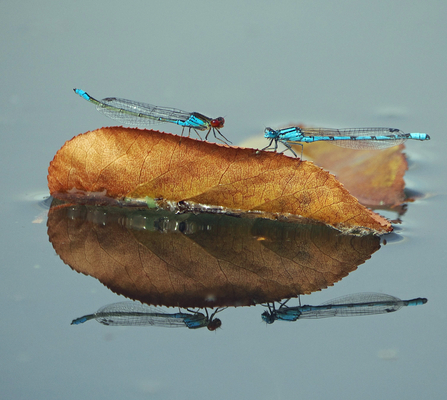
Small red-eyed and common blue damselflies (C) Rod Jones
The combatants belong to different species of male damselfly. In the red corner – a small red-eyed; in the blue corner – a common blue. The battleground is a floating, golden-brown leaf that’s curled up to form a ledge on which the tiny opponents are poised. The sunlight picks out the patterns of veins in the leaf and creates a gorgeous mirror image of the scene.
It’s a reminder that wildlife doesn’t have to be big to be dramatic and fascinating. Like red deer stags locking antlers during the rut, or gigantic bull seals grappling on the beach, these two male insects are engaging in a struggle for dominance and territory.
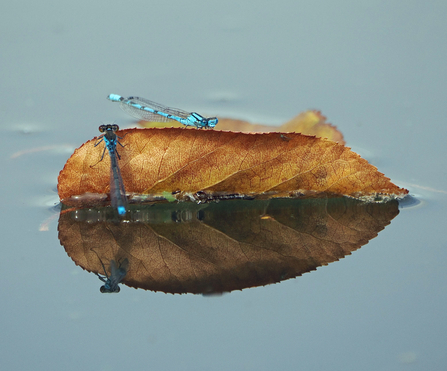
Small red-eyed and common blue damselflies (C) Rod Jones
My photos appear to show a certain amount of cunning on the part of the small red-eyed damselfly. Seconds before the face-to-face confrontation, he can be seen hauling himself out of the water and up the vertical face of the leaf so he can ambush the blue king of the castle.
So, who’s the victor in the Carp Lake showdown – red or blue? To be honest, I’ve no idea. There are similar trials of strength taking place on other floating leaves that grab my attention, enticing me to turn my telephoto lens in their direction. When I look back at the curled leaf, it’s empty…for a few seconds at least, until more challengers join the fray.
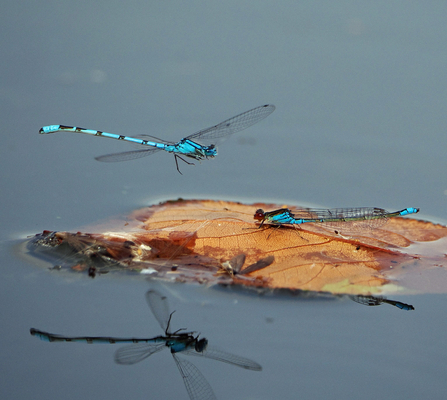
Common blue and small red-eyed damselflies (C) Rod Jones
I watch another small red-eyed defending a flat, brown floating leaf against an aerial attack from a common blue, which is buzzing low over it. The red soon takes to the air, and the two damselflies threaten each other as they fly a few centimetres above the surface.
The action isn’t limited to one-on-one duels: several males are fighting over the same leaf at the same time. But, while there are plenty of close shaves, I don’t see any crash into each other. It seems that these territorial clashes may be more posturing than full-on physical battles.
A few years ago, I wouldn’t have been able to watch small red-eyed damselflies at North Cave. This species only arrived in the UK from Europe in 1999. According to the British Dragonfly Society, it spread spectacularly through southeast England and the Isle of Wight in the years immediately following its first appearances. It’s now reached Devon in the west and North Yorkshire in the north, but expansion has slowed.
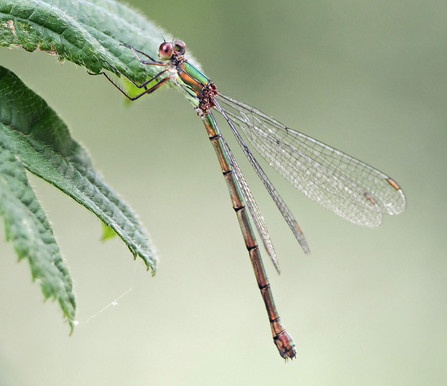
Willow emerald damselfly (C) Rod Jones
A couple of years ago, I spotted an even more recent colonist at North Cave – a willow emerald damselfly. These beautiful metallic green insects arrived in East Anglia from Europe in 2009, before moving north and west. They’re less obtrusive than the small red-eyeds, spending a lot of their time in the trees: the one I saw was hidden among the branches and leaves next to Dryham Lane.
It’s hot and dry on the reserve today: Yorkshire is in the middle of a drought after months of below-average rainfall. The arid conditions are bad news for many kinds of wildlife, but the changing climate has probably encouraged these two species of damselfly to venture up here.
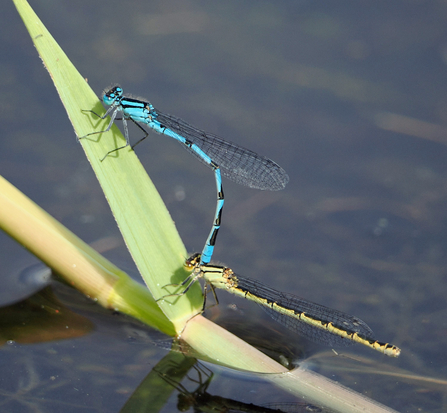
Common blue damselflies mating (C) Rod Jones
Territorial fights aren’t the only damselfly activity in the shallows of Carp Lake this afternoon: there’s a lot of mating going on too. Common blues are coupling on leaves and stalks, then flying around above the water with the blue males and pale green females still joined together.
At least ten different species of damselfly can be seen at North Cave. They’re smaller, more delicate and less showy than the dragonflies that whizz around the reserve’s ponds and pathways – but they’re spectacular if you take the time to seek them out.
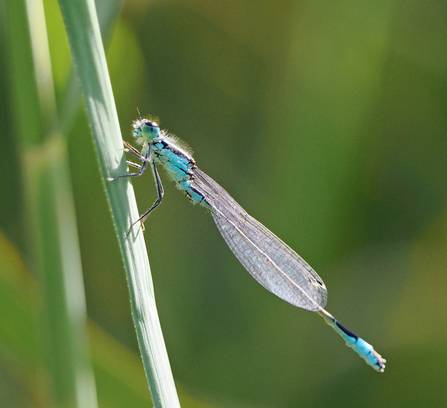
Male blue-tailed damselfly (C) Rod Jones
One of my favourite encounters on this sparkling day is with a male blue-tailed damselfly that’s clinging unobtrusively to a stalk among the lush vegetation. It’s a common species, but gorgeous nonetheless, with its enormous, baby blue eye looking straight into my camera as the sun illuminates the fine hairs on its head and thorax.
In a few weeks, as summer fades, the damselflies will start to disappear, and we’ll find different natural wonders to enjoy among North Cave’s rich wildlife habitats.

